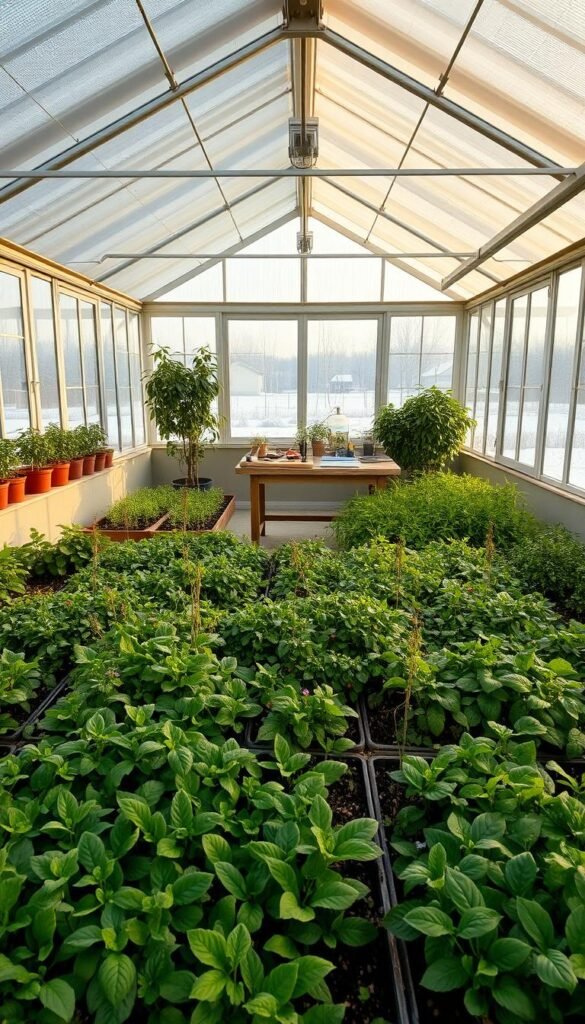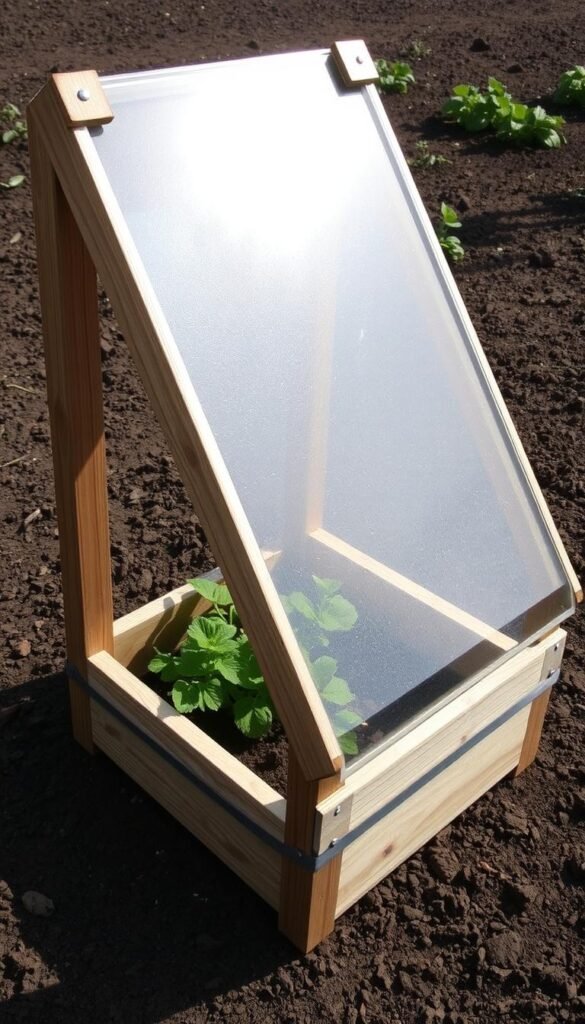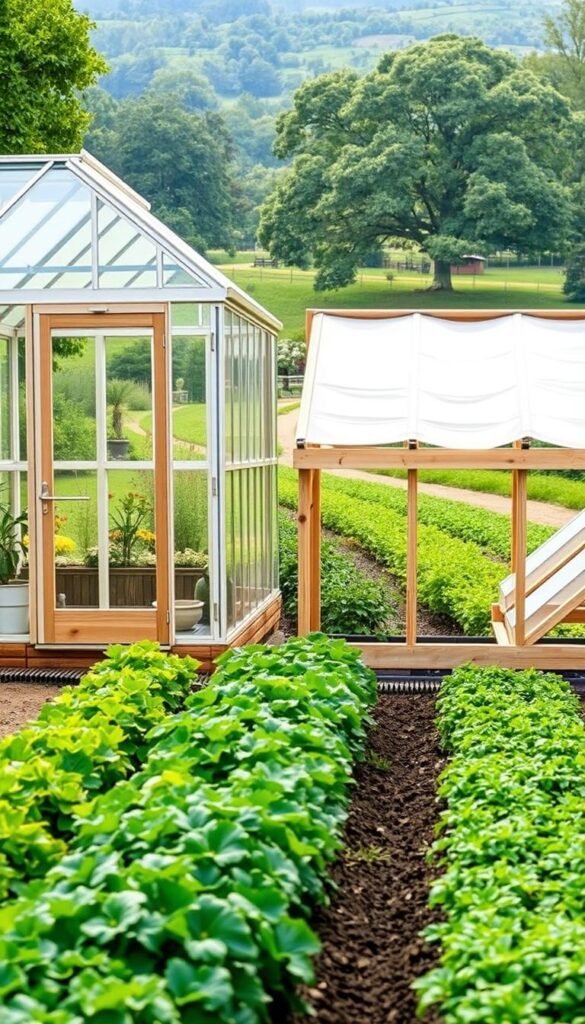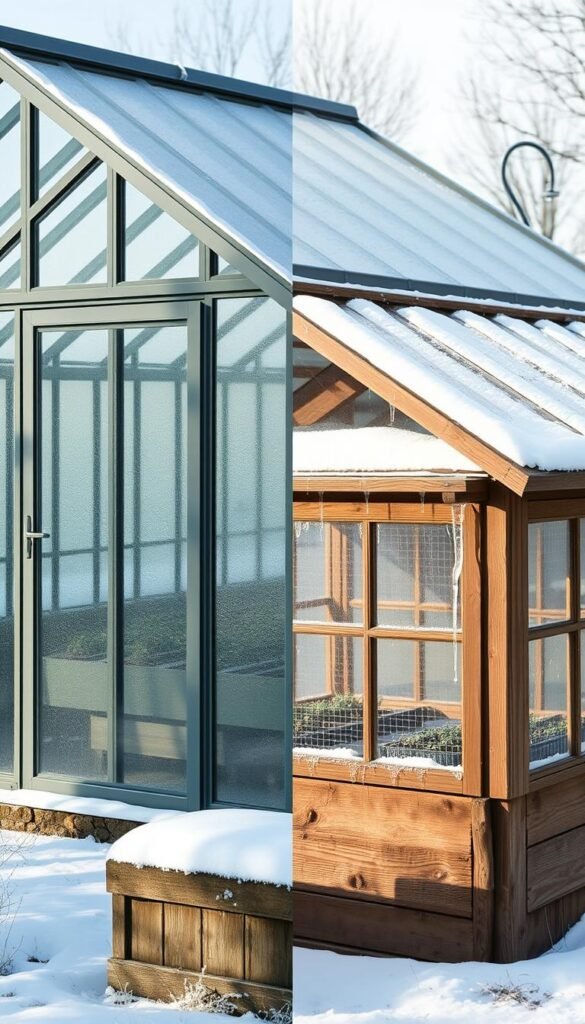When temperatures drop, protecting your plants becomes essential for maintaining a thriving garden. Two popular options let you grow through frosty months: simple sun-powered boxes and larger climate-controlled spaces. Both create sheltered microclimates, but their approaches differ dramatically.
One method uses natural warmth from sunlight, perfect for small-scale projects. These compact setups work well for cold-hardy vegetables like spinach or kale, as detailed in our guide to cold frame gardening techniques. The other option offers full environmental management, letting you cultivate delicate species year-round.
Your choice depends on three main factors: available space, budget, and what you hope to achieve. Smaller setups cost less upfront but have seasonal limits. Larger investments provide more flexibility yet require ongoing maintenance. We’ll break down installation expenses, temperature control methods, and ideal uses for each system.
By understanding these differences, you’ll confidently select the right tool for your needs. Whether you’re preserving herbs through December or growing tropical blooms in January, proper planning makes winter productivity possible.
The Essentials of Winter Gardening with Enclosed Structures

Enclosed gardening setups turn harsh winters into growth opportunities. These structures act like cozy blankets, shielding your greens from biting winds and icy surprises. By managing temperature and humidity, they create a stable environment where plants thrive instead of just surviving.
Why You Need a Controlled Environment
Freezing nights can wreck even hardy plants. Enclosed spaces trap daytime warmth, keeping soil 10-20°F warmer than outside. This protection prevents frost damage to roots and leaves. Consistent conditions also reduce plant stress, letting them focus energy on growth.
The Role of Temperature and Humidity in Plant Growth
Plants need specific conditions to absorb nutrients and photosynthesize. Too cold, and their cells freeze. Too dry, and they wilt. A balanced climate inside your structure:
| Factor | Ideal Range | Plant Benefit |
|---|---|---|
| Temperature | 40-65°F | Prevents dormancy |
| Humidity | 50-70% | Reduces water stress |
| Frost Protection | Above 32°F | Saves root systems |
Proper airflow prevents mold while retaining moisture. For extra frost defense, pair structures with methods like container insulation. Remember: different plants need different care. Leafy greens handle cooler temps better than tropicals.
Exploring Cold Frames: Affordable and Compact Solutions

For gardeners craving simplicity, these sun-powered boxes deliver big results without complex setups. Their no-frills design focuses on practicality, offering a smart entry point for extending your growing calendar.
Key Features and Benefits of Cold Frames
The magic lies in their straightforward construction. A transparent lid—often recycled windows or polycarbonate panels—sits atop a shallow wooden or metal frame. This setup captures sunlight like a solar oven, creating a cozy microclimate for plants.
Three standout advantages make them garden favorites:
- Space efficiency: Fits snugly in corners, patios, or raised beds
- Seedling shield: Safeguards young plants during spring transitions
- Season stretching: Adds 4-6 weeks to fall harvests
Maintenance, Cost, and Practical Considerations
You’ll spend more time enjoying your greens than maintaining the structure. Daily tasks involve:
- Wiping the lid for maximum light penetration
- Cracking it open on warm days for airflow
- Securing it against strong winds
Budget-friendly options start at $30 for DIY builds using old storm windows. Pre-made units hover around $100, though prices climb for heavy-duty frames with automatic vent openers. Position yours against a south-facing wall for added warmth, or move it easily to protect different plant groups.
While perfect for hardening off seedlings or sheltering kale, remember: these aren’t tropical havens. For year-round growing strategies, consider pairing them with other methods. Their charm lies in doing one thing exceptionally well—turning chilly days into productive gardening sessions.
Greenhouse vs. Cold Frame: Which Setup Is Right for Winter Gardening?

The battle between these two gardening tools isn’t about superiority—it’s about suitability. Your choice shapes what thrives in your backyard when snowflakes fall. Let’s explore how each option tackles growing challenges.
Year-Round Cultivation and Climate Control
Traditional greenhouses unlock endless growing possibilities. These climate-controlled spaces maintain tropical humidity levels and steady warmth, letting you nurture pineapples or orchids even during blizzards. Cold frames, while excellent for frost protection, can’t replicate this precision.
| Feature | Greenhouse | Cold Frame |
|---|---|---|
| Temperature Range | 50-85°F | 35-65°F |
| Suitable Plants | Tropicals, citrus, tomatoes | Kale, spinach, herbs |
| Initial Cost | $500-$2,000+ | $30-$300 |
| Maintenance | Heating, vents, irrigation | Daily lid adjustments |
Optimizing Your Garden Space and Budget
Permanent structures demand careful placement—you’ll need at least 50 square feet for even small greenhouses. Mobile cold frames thrive on patios or between raised beds. Budget-wise, consider long-term costs: heating a large glass house triples winter energy bills compared to season extension techniques using temporary covers.
Ask yourself: Do you want fresh lemons in January or just extra lettuce through December? Your answer reveals which option fits your space, budget, and culinary dreams.
Comparing Design, Structure, and Performance

Building a winter-ready garden starts with choosing materials that balance durability and efficiency. Let’s break down how different designs tackle frost protection and growth optimization.
Materials and Construction: Glass, Wood, and Plastic
Permanent structures often use tempered glass or polycarbonate panels supported by metal or treated wood frames. These materials withstand heavy snow loads while maximizing sunlight exposure. Glass offers superior clarity but requires sturdy framing, while plastic diffuses light to prevent plant scorching.
Simpler setups lean on repurposed windows or acrylic sheets over wooden boxes. These prioritize heat retention over longevity, using materials you might already own. Metal hinges and latches help secure lids against harsh winds.
Heating, Ventilation, and Extending the Growing Season
Active climate control separates advanced setups from basic ones. Larger spaces often use electric heaters paired with effective insulation strategies, maintaining tropical conditions even in January. Vent fans and automated louvers prevent overheating during sunny spells.
Passive systems rely on clever design. Dark-painted walls absorb daytime warmth, while angled lids capture low winter sun. Open the lid slightly on mild days to balance humidity—no electricity needed. This approach adds 6-8 weeks to your growing season for cool-weather crops.
Soil management varies too. Ground-level beds in compact setups use existing earth, while raised tables in larger structures allow better root temperature control. Both methods protect plants, but your choice depends on how many months you want fresh harvests.
Final Thoughts on Selecting Your Winter Gardening Setup
Choosing the right protective structure boils down to your goals and resources. New gardeners or those with tight spaces often find cold frames ideal—they’re affordable, portable, and perfect for hardening off seedlings or sheltering leafy greens. For detailed comparisons, explore this cold frame vs greenhouse analysis.
Dedicated growers craving year-round variety might prefer larger investments. Traditional setups offer precise climate control for tropicals but demand more space and maintenance. Pair either option with frost-resistant crops to maximize yields.
Consider your commitment level: simple lids work wonders for seasonal extensions, while permanent structures unlock endless possibilities. Both protect plants effectively—your budget and ambition decide which environment fits best.
Start small if unsure. A basic frame teaches temperature management skills, while future upgrades let you grow citrus alongside kale. Whatever you pick, consistent care matters most for winter success.






